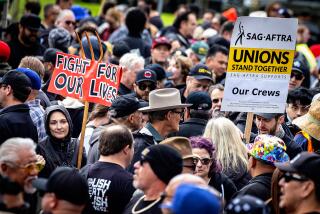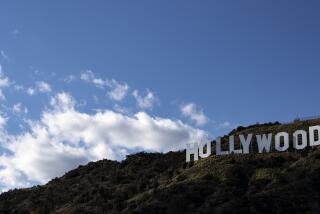Seeing Red
- Share via
When producer Jack Warner stood on the roof of his studio, watching the bloodshed in the streets below in early October 1945, he probably expected the public to side with him against the picketing unionists of the progressive Conference of Studio Unions. Even back in the liberal 1930s, many Americans assumed that unions per se were crooked or reactionary. Actually CSU’s arch-adversary, the International Alliance of Theatrical Stage Employees, was both: enmeshed with organized crime, quick to provide goons to shatter picket lines and indifferent to the needs of its members. (Edmund Wilson wrote that F. Scott Fitzgerald planned to depict the “racketeering and gangsterism revealed” of IATSE in his unfinished novel, “The Last Tycoon.”) Until 1940, IATSE was headed by George Browne, employed by mobsters, and Willie Bioff, a professional hood sometimes called Willie “Buy-Off.” They were finally jailed and heavily fined for extorting vast sums from studios, which paid handsomely for “labor peace.”
Such peace seemed rare to those who knew labor history: In 1910 the McNamara brothers, officials of the AFL Structural Iron Workers, dynamited the printing plant of the Los Angeles Times when their union was on strike. Twenty employees were killed. Soon L.A. became a fiercely anti-labor town, and the Hollywood moguls detested unions once the advent of sound prompted the organizing of technicians. At the same time, the Depression generated sympathy for working people; after all, management was likely to exploit and pay them badly.
The CSU was an honorable cluster that included the unions of painters, set decorators, carpenters, office employees, screen publicists and story analysts. It was designed to be as democratic as IATSE was dictatorial, yet it was occasionally in the wrong about its tactics--such as beating up thugs who had been sent to disrupt strikes. At the height of the domestic Cold War, when liberalism was equated with communism, when right-wingers believed that Jews and communists were barely distinguishable, anti-communism was closely allied with animosity toward labor.
The long, violent and extremely complex CSU strike of 1945 and the ensuing lockout of 1946 are thoughtfully explored in Gerald Horne’s very useful “Class Struggle in Hollywood 1930-1950.” From the start, IATSE and the studio chiefs opposed the existence of the CSU, which was intent on better pay and reasonable schedules for people who often worked until late at night, even on Saturdays. Browne and Bioff were replaced at IATSE by Roy Brewer, chairman of the AFL Film Council and the most powerful unionist in Hollywood. In the blacklist era, he helped to refine the clearance business--that is, he negotiated the confessions and rehabilitations of ex-communists and liberals who regretted their previous associations with the Left. Brewer steered them to the FBI to give alleged “information” about communists and then to the House Committee on Un-American Activities. Along with the American Legion and the columnist Hedda Hopper, he had the power to determine who could--or couldn’t--be employed by the studios.
In 1947 Brewer, an impassioned Red-baiter, told HUAC that the Soviet Union was financing “the takeover of the motion picture industry” and that American communists were trying “to control the unions” in order to tyrannize the producers and “force their ideas” into movie scripts. The fantasy of Moscow gold permeating the film business was on a par with the notion that MGM or Paramount--which were run by loyal Republicans--might produce left-wing films.
Often accused of scarlet intentions, the CSU was really at odds with the communists. The party had obeyed the wartime no-strike pledge until the Allies’ victory, whereas several CSU unions struck months beforehand. The CSU was also willing to deal with management, rather than to regard capitalists as total villains. The leader of CSU, Herbert Sorrell, was militant, dedicated but also naive; unskilled at negotiations, he expected more sense and decency from the moguls than they possessed.
Despite the communists’ objections, the CSU strike began in March 1945. On certain days in October the air around Warner Bros. studio was thick with tear gas as well as death threats; fistfights erupted between strikers and scabs and policemen; chains, metal pipes and wooden mallets were among the strikebreakers’ weapons; arms and legs were broken along with car windows. Fire hoses knocked people off their feet, and they landed on pavements covered with smashed glass. As so-called labor unrest swept the country--mainly because unions aimed to raise the salaries frozen during the war--the CSU battles were sometimes compared to the start of a civil war.
As the CSU strike dragged on for seven months, production was slowed and millions of dollars were lost. Horne deduces that fear of the mobsters made many employees cross the picket lines and resume work, but I suspect that the dread of being called communist was an even sharper spur, as well as the need (or greed) for money. An admirable handful of stars wouldn’t cross the lines, including Peter Lorre, Bette Davis and Edgar Bergen; but Lillian Gish, cast in “Duel in the Sun,” simply walked past the studio, waving at the strikers. CSU also picketed movie theaters, and one group ruined the suspense of a thriller by identifying the murderer (Ralph Bellamy!), urging moviegoers to save their cash.
It’s hard to nail down the effect of the mob on the movie business because so much evidence was cleverly hidden. Certainly criminals had infiltrated many unions throughout the country, and we know that some racketeers kept company with producers Harry Cohn of Columbia, Jack and Harry Warner and Howard Hughes and such performers as George Raft, Robert Mitchum and Frank Sinatra. Orson Welles observed, “A group of industrialists finance a group of gangsters to break trade unionism, to check the threat of Socialism, the menace of Communism or the possibility of democracy .... When the gangsters succeed at what they were paid to do, they turn on the men who paid them.” Pay-offs of all sorts were common throughout the studio system, and at times the moguls also managed to turn unionists on the same side against one other. (Jessica Mitford was fond of a song that parodied a righteous left-wing anthem: “The working class can kiss my ass/I’ve got the foreman’s job at last.”)
The strike ended on Oct. 29. This paper declared that it was “nobody’s victory” because various issues were still to be negotiated or arbitrated. A brief strike in 1946 did win a pay hike and a 36-hour workweek, but further disputes about the difference between “set erection” and “construction” led to another strike. The result was the lock-out that defeated the CSU and--many thought--the possibility of enlightened unions. Ejected from the studios, some members of the CSU began to form rival unions, and the remains of the CSU were gradually scattered. Moreover, the whole strike and its consequences seemed like a dry run for the blacklist, fueled with red-hating and anti-Semitism. (Most producers were Jews, but their efforts to crush unions didn’t protect them from being seen as un-American.)
Horne makes it plain that the communist leadership wasn’t involved in the strike, and he provides a clearsighted account of the party in Hollywood. Although communists were active on behalf of film workers, especially writers, he overrates their effect on the industry at large. But he is fair in his criticism of the party and the CSU: Both neglected the rights of black workers (even though the party had exerted itself for the Scottsboro Boys and on behalf of desegregated housing). And the cycle of movies that condemned anti-Semitism (“Crossfire,” “Gentleman’s Agreement”) and white racism (“Home of the Brave,” “No Way Out”) was hastily discontinued after the committee’s hearings of 1947. Although those pictures now seem tame and patronizing, they were radical for an industry that was galloping toward the right. Central to the destruction of the CSU were baseless charges of communism. No matter how bitter a strike might be today, the political accusations couldn’t be quite as deadly.
More to Read
The biggest entertainment stories
Get our big stories about Hollywood, film, television, music, arts, culture and more right in your inbox as soon as they publish.
You may occasionally receive promotional content from the Los Angeles Times.










